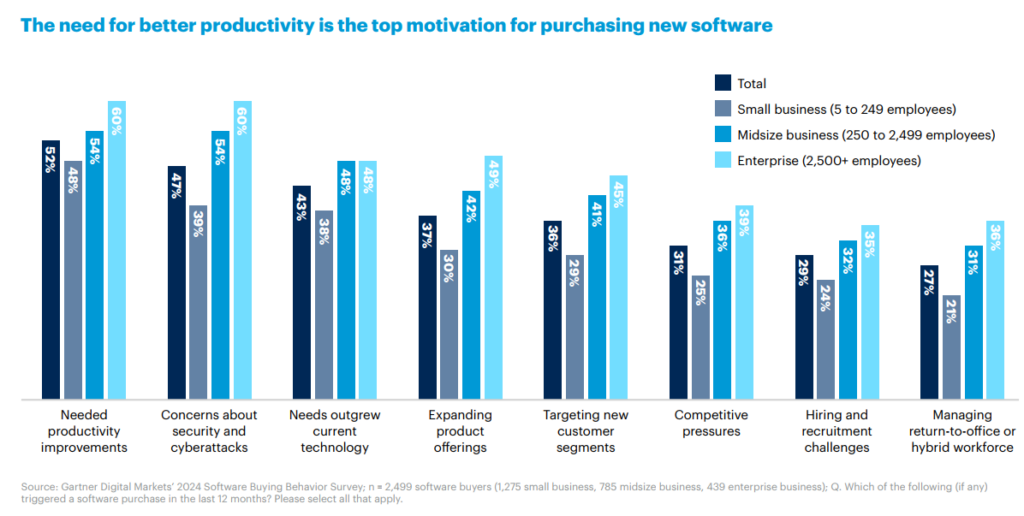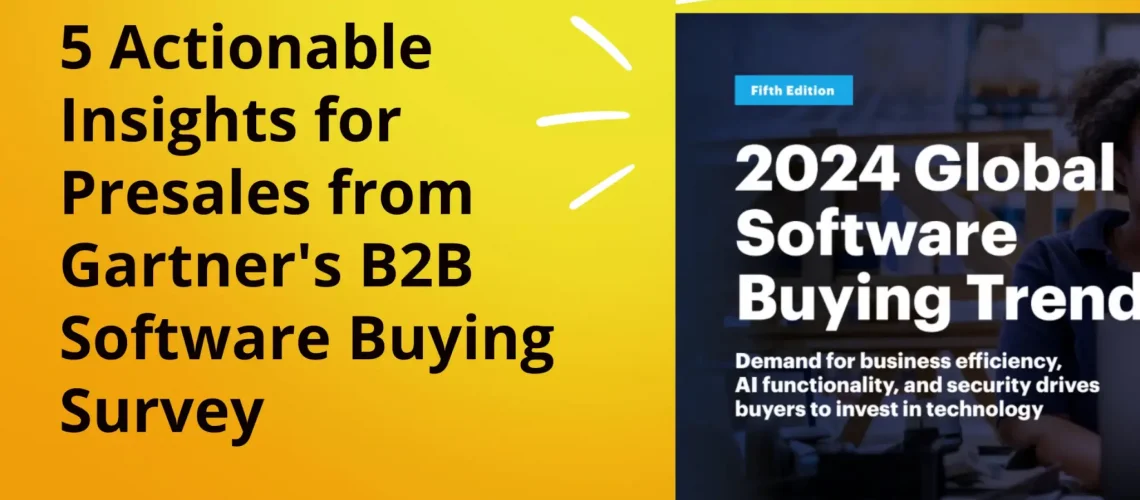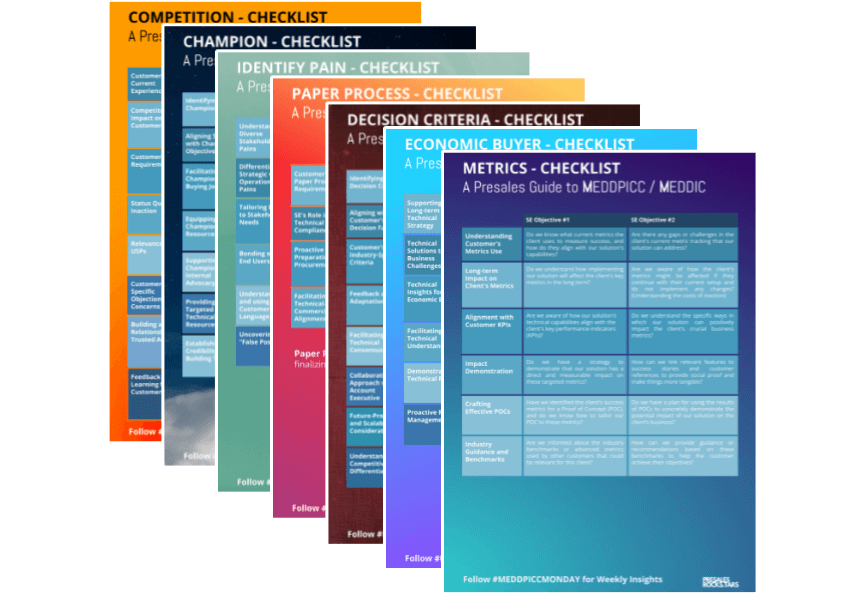Gartner’s 2024 Global Software Buying Trends report provides invaluable insights for presales professionals. With data gathered from 2,499 software buyers, this survey highlights key factors that influence purchasing decisions. Here are five actionable learnings presales teams can implement to enhance their effectiveness and drive sales.
#1 Proactively Address Security Concerns
Why? Security certification and data privacy are top priorities for software buyers, as highlighted in Gartner’s 2024 Global Software Buying Trends report. Buyers are increasingly concerned about the security and privacy of their data, making it a critical factor in their decision-making process. Addressing these concerns proactively can significantly enhance your credibility and build trust with potential clients.

How?
- Early Engagement: Introduce Security Documentation Early
- Initial Meetings: During your first interactions with prospects, bring up your company’s commitment to security. This can be a strong opening topic as it addresses one of their primary concerns right away.
- Highlight Certifications: Present your security certifications (e.g., ISO 27001, SOC 2) and data privacy compliance measures (e.g., GDPR, CCPA). These certifications serve as proof of your commitment to security.
- Tailored Information: Provide the Right Level of Detail at the Right Time
- Early-Stage Prospects: Offer introductory security documentation that is easy to understand and digest. This could be in the form of a high-level overview or an executive summary that highlights your key security practices without overwhelming technical detail.
- Late-Stage Opportunities: For prospects who are further along in the buying process, provide more comprehensive and technical security documentation. This could include detailed security whitepapers, penetration testing results, and specifics about your encryption methods and data protection strategies.
Actionable Steps:
- Create Security Overview Documents:
- High-Level Security Overview: Develop a concise, one-page document that outlines your key security practices, certifications, and compliance measures. This document should be designed to give prospects a quick and reassuring overview of your security posture.
- Detailed Security Whitepapers: Produce in-depth whitepapers that delve into the specifics of your security measures. These should be technical documents suitable for review by InfoSec teams.
- Security-Focused Communication:
- Proactive Communication: Regularly communicate your security practices and updates to prospects. This can be done through newsletters, blog posts, or dedicated security updates on your website.
- Security in Sales Pitches: Incorporate security discussions into your sales pitches. For instance, during product demos, highlight security features and how they protect customer data.
- Offer Security Audits and Assessments:
- Free Security Assessments: Offer prospects a free security assessment or audit as part of your presales process. This can help demonstrate your commitment to their security and provide them with valuable insights into potential vulnerabilities.
- Customized Security Reports: Provide tailored security reports that address the specific concerns and requirements of each prospect. These reports can be used to reassure them of your ability to meet their security needs.
- Train Your Team:
- Security Training for Sales Teams: Ensure that your sales and presales teams are well-versed in your company’s security measures and can confidently discuss them with prospects. Regular training sessions and updates on the latest security trends and your company’s security posture are essential.
- Technical Training for Presales Engineers: Equip your presales engineers with the technical knowledge required to answer in-depth security questions and address specific concerns raised by prospects.
- Leverage Security as a Differentiator:
- Competitive Advantage: Use your strong security posture as a differentiator in the market. Make it clear to prospects that your commitment to security is not just about compliance but about providing them with peace of mind and protecting their valuable data.
- Case Studies and Testimonials: Develop case studies and gather testimonials from clients who have benefited from your security measures. Highlight how your security practices have helped them avoid breaches and protect their data.
By proactively addressing security concerns and integrating these practices into your presales strategy, you can build trust with prospects, differentiate your solution, and increase your chances of closing deals. Security is not just a feature but a fundamental aspect of your value proposition that can significantly influence buying decisions.
#2 Leveraging Customer Reviews in Presales
Why? Customer reviews are a crucial part of the decision-making process for software buyers. Gartner’s 2024 Global Software Buying Trends report highlights that customer reviews are the number one content source used by prospects to make purchase decisions. Knowing what is written in these reviews allows presales teams to anticipate concerns or questions and address them proactively, enhancing trust and credibility.

How?
- Stay Informed About Your Reviews
- Regular Monitoring: Make it a priority to regularly check review sites like Capterra, G2, and Trustpilot for new reviews about your product. This helps you stay updated on customer feedback and identify recurring themes.
- Analyze Feedback: Pay close attention to both positive and negative feedback. Understand what customers appreciate and what challenges they face. This insight is invaluable for tailoring your sales approach.
- Incorporate Reviews in Sales Discussions
- Address Concerns Early: During sales calls or demos, proactively bring up common concerns mentioned in reviews. Addressing these upfront shows that you are transparent and responsive to customer feedback.
- Highlight Positive Feedback: Use positive reviews as social proof. Highlight specific quotes or case studies from reviews that align with the prospect’s needs and industry.
Actionable Steps:
- Create a Review Monitoring System:
- Dedicated Time for Review Monitoring: Assign a team member to monitor reviews regularly and compile a report on key themes and feedback. This can be done weekly or bi-weekly.
- Use Tools for Automation: Utilize tools and platforms that can alert you when new reviews are posted. This ensures you don’t miss any critical feedback.
- Develop a Review Response Strategy:
- Respond to Reviews: Engage with reviewers by responding to their comments. Thank them for positive feedback and address any negative points constructively. This shows prospects that you are attentive and committed to customer satisfaction.
- Create FAQs Based on Reviews: Develop a FAQ section on your website or sales collateral that addresses common concerns raised in reviews. This can help mitigate potential objections during the sales process.
- Integrate Reviews into Sales Materials:
- Use Reviews in Presentations: Include relevant review excerpts in your sales presentations. This can help reinforce the benefits of your product and provide real-world validation.
- Create Review-Based Case Studies: Develop case studies that are built around customer reviews. Highlight how your product solved specific problems mentioned in the reviews and the outcomes achieved.
- Train Your Team:
- Review Knowledge Training: Ensure your sales and presales teams are well-versed in the latest reviews. Regularly update them on new feedback and discuss how to leverage this information in their interactions with prospects.
- Role-Playing Scenarios: Conduct role-playing sessions where sales reps practice addressing common concerns mentioned in reviews. This helps them prepare for real-life scenarios and respond confidently.
- Leverage Positive Reviews Strategically:
- Highlight Key Benefits: Use positive reviews to highlight key benefits and differentiators of your product. Align these benefits with the specific needs and pain points of your prospects.
- Showcase Industry-Specific Reviews: If you have reviews from customers in the same industry as your prospect, make sure to highlight these. It adds an extra layer of relevance and credibility.
Example Implementation:
- Review Integration in Demos:
- During a product demo for a financial services prospect, you could say, „Many of our customers in the financial sector have highlighted how our software’s advanced security features have given them peace of mind. For instance, a recent review from XYZ Bank mentioned how our encryption protocols significantly enhanced their data protection.“
- Proactive Review Discussion:
- In a sales call, you might address a common concern: „I noticed in some reviews that customers initially found our setup process complex. We’ve taken that feedback seriously and have since improved our onboarding process. Let me walk you through the new streamlined steps.“
By staying informed about what is written in your reviews and strategically integrating this information into your presales activities, you can better address your prospects‘ concerns, build trust, and increase your chances of closing deals. Customer reviews are a powerful tool – use them to your advantage to create a more compelling and credible sales narrative.
#3 Adopting a Post-Sales Mindset in Presales
Why? Building trust and confidence with prospects is crucial. Gartner’s 2024 Global Software Buying Trends report emphasizes the importance of presales teams helping customers envision the post-signature phase. This approach not only shifts the focus from feature comparisons to collaborative success but also ensures that prospects feel supported throughout their journey, increasing the likelihood of a sale.

How?
- Discuss the Implementation Process Early
- Implementation Roadmap: Introduce a detailed implementation roadmap during the presales phase. This should outline key milestones, expected timelines, and responsibilities.
- Realistic Expectations: Set realistic expectations about the implementation process, including potential challenges and how they will be addressed. This transparency builds trust and shows your commitment to the customer’s success.
- Highlight Support and Collaboration
- Support Structure: Clearly explain the support structure that will be available to the prospect post-signature. This includes customer success managers, technical support, and any additional resources they can rely on.
- Collaboration Tools: Showcase any collaboration tools or platforms that will be used to facilitate communication and project management during the implementation phase.
Actionable Steps:
- Create Detailed Implementation Documents:
- Implementation Guide: Develop a comprehensive implementation guide that includes step-by-step instructions, key contacts, and timelines. Share this document early in the sales process.
- Case Studies on Implementation: Provide case studies that focus on the implementation phase. Highlight how your team successfully navigated potential obstacles and delivered results on time.
- Conduct Implementation Workshops:
- Workshops for Prospects: Offer workshops or webinars that walk prospects through the typical implementation process. This can help demystify the process and answer any preliminary questions they might have.
- Interactive Q&A Sessions: Host interactive Q&A sessions with your implementation team where prospects can ask detailed questions about the post-signature phase.
- Train Your Sales Engineers:
- Implementation Training: Ensure your sales engineers are well-versed in the implementation process. They should be able to discuss common challenges and how your team mitigates them.
- Scenario Planning: Conduct scenario planning sessions where sales engineers practice discussing post-signature phases with prospects. This helps them address concerns confidently and build trust.
- Use Visual Aids:
- Implementation Timeline Visuals: Use visual aids like Gantt charts or project timelines during sales meetings to visually represent the implementation process. This helps prospects grasp the sequence of events and key milestones.
Example Implementation:
- Implementation Roadmap Presentation:
- During a sales meeting, present an implementation roadmap: „Here’s an overview of what the first 90 days will look like after you sign with us. We’ll start with a kick-off meeting, followed by system setup and integration. By week four, you’ll have your first training session. We’ve mapped out each step to ensure a smooth transition and avoid any disruptions.“
- Support Structure Discussion:
- In a conversation with a prospect, emphasize the support they’ll receive: „Once you’re on board, you’ll have a dedicated customer success manager who will be your primary point of contact. Additionally, our technical support team is available 24/7 to assist with any issues. We’re here to ensure your team meets its objectives and deadlines.“
- Workshops and Q&A Sessions:
- Offer a workshop: „We hold monthly workshops where we walk through the typical implementation process and address common questions. I can sign you up for our next session so you can see firsthand how we manage this phase and ensure a successful rollout.“
By adopting a post-sales mindset in presales, you help prospects envision a successful implementation, build trust, and shift the discussion from just features to a collaborative partnership aimed at achieving their goals. This approach not only differentiates you from competitors but also positions you as a committed partner dedicated to the prospect’s success.
#4 Demonstrating Understanding of Customer Needs
Why? Customers prioritize vendors who truly understand their specific situations and challenges over those who simply showcase product features. Gartner’s 2024 Global Software Buying Trends report highlights that a deep understanding of customer needs significantly influences buying decisions. This approach builds trust, aligns your solution with their goals, and demonstrates your genuine interest in their success.
How?
- Deep Discovery Process
- Detailed Questions: Spend considerable time in the discovery phase, asking detailed questions about the prospect’s business, challenges, and objectives. This shows that you are invested in understanding their unique situation.
- Listen Actively: Actively listen to their responses and take notes. This not only helps you gather crucial information but also makes the prospect feel heard and valued.
- Tailor Your Approach
- Customized Solutions: Tailor your presentations and demos to directly address the prospect’s specific challenges. Avoid generic pitches and instead focus on how your solution can solve their unique problems.
- Relevant Examples: Use examples and case studies that are relevant to the prospect’s industry and specific situation. This makes your solution more relatable and convincing.
Actionable Steps:
- Conduct Comprehensive Discovery Sessions:
- Structured Discovery Meetings: Hold structured discovery meetings where you ask in-depth questions about the prospect’s pain points, business processes, and goals. Ensure these meetings are collaborative and focused on understanding their needs.
- Use Discovery Tools: Utilize tools and templates to document the information gathered during these sessions. This can include discovery questionnaires, business process maps, and stakeholder analysis.
- Develop Personalized Presentations:
- Custom Demo Scripts: Develop demo scripts that address the specific needs and challenges of the prospect. Highlight how your solution can overcome these challenges and help them achieve their objectives.
- Industry-Specific Content: Create content that is tailored to different industries and business scenarios. This can include industry-specific case studies, whitepapers, and solution briefs.
- Engage in Solution-Oriented Conversations:
- Problem-Solving Discussions: Focus your conversations on solving the prospect’s problems rather than just showcasing features. Discuss potential solutions and how your product can be adapted to meet their unique needs.
- Continuous Engagement: Maintain continuous engagement with the prospect throughout the sales process. Regular check-ins and follow-ups show your commitment to their success.
- Show Genuine Interest:
- Understand Their Objectives: Make an effort to understand the broader objectives of the prospect’s business. This includes their strategic goals, key performance indicators (KPIs), and long-term vision.
- Align Your Solution: Align your solution with these objectives and demonstrate how it can support their strategic initiatives. This approach positions you as a partner in their success rather than just a vendor.
- Provide Strategic Insights:
- Share Best Practices: Share industry best practices and insights that can help the prospect improve their business processes and achieve their goals. This positions you as a knowledgeable advisor.
- Consultative Approach: Take a consultative approach in your interactions. Offer advice and recommendations that go beyond your product, showing that you are genuinely invested in their success.
Example Implementation:
- Customized Discovery Session:
- During a discovery session, ask detailed questions like: „Can you walk me through your current process for handling X? What are the main challenges you’re facing? What are your top priorities for the next quarter?“
- Listen carefully to their responses and summarize their key points to ensure you’ve understood correctly: „So, your main challenge is Y, and you’re looking to achieve Z within the next six months, correct?“
- Tailored Presentation:
- In your presentation, say: „Based on our discussions, I understand that one of your biggest challenges is streamlining your workflow to improve efficiency. Let me show you how our solution has helped similar companies in your industry reduce their processing time by 30%.“
- Engage in Solution-Oriented Conversations:
- During follow-up meetings, focus on how your solution can be specifically configured to meet their needs: „Given your need for improved data integration, we can set up our system to automatically sync with your current software, reducing manual entry and errors.“
- Strategic Insights:
- Share insights during conversations: „Many of our clients in the healthcare industry have found that implementing automated reminders significantly improves compliance rates. This might be a valuable addition to your process as well.“
By demonstrating a deep understanding of your customer’s needs and focusing on their challenges and objectives, you can build stronger relationships and position yourself as a trusted advisor. This approach not only enhances your credibility but also increases the likelihood of a successful sale.
#5 Highlighting Productivity Benefits in Presales
Why? In today’s productivity-driven age, organizations are constantly seeking ways to do more with their existing resources. Artificial Intelligence (AI) has emerged as a significant accelerator for productivity, particularly at the management level. Highlighting the productivity benefits of your solution in presales discussions can be a compelling way to differentiate your offering and drive purchasing decisions.

How?
- Focus on AI-Powered Benefits, Not Technical Details
- Emphasize Outcomes: Shift the focus from technical details of AI algorithms to the tangible benefits they deliver. Highlight how AI streamlines workflows, automates repetitive tasks, and improves decision-making.
- Quantify Productivity Gains: Clearly articulate the productivity gains that AI-powered features enable, such as time saved, cost reductions, and improved resource allocation.
Actionable Steps:
- Showcase AI-Powered Functionality:
- Live Demonstrations: Offer live demonstrations that illustrate how AI streamlines processes and improves productivity. Focus on the outcomes achieved rather than the technical intricacies of AI algorithms.
- Use Case Scenarios: Present real-world use cases that demonstrate how AI-powered features solve common business challenges and deliver measurable results.
- Quantify Productivity Gains:
- Case Studies: Share case studies and success stories that quantify the productivity benefits achieved by other clients using your solution. Highlight specific metrics and outcomes rather than technical details.
- ROI Calculators: Develop ROI calculators that allow prospects to estimate the potential productivity gains from implementing your solution. Focus on quantifiable benefits that resonate with management-level stakeholders.
- Address Management-Level Concerns:
- Executive Summaries: Create executive summaries that highlight the strategic benefits of your solution for management-level stakeholders. Focus on how AI enhances productivity and drives business outcomes.
- Strategic Alignment: Align your solution with the organization’s broader goals and priorities, emphasizing its role in driving efficiency and achieving strategic objectives.
- Provide Thought Leadership:
- Educational Content: Produce thought leadership content that explores the business benefits of AI in driving productivity. Focus on practical insights and best practices that resonate with management-level stakeholders.
- Industry Insights: Share industry insights and trends related to AI adoption and productivity improvements. Position your solution as a strategic enabler of productivity in the context of broader industry shifts.
Example Implementation:
- Live Demonstration of AI Features:
- During a product demo, showcase how your AI-powered project management software automatically prioritizes tasks, assigns resources, and optimizes project timelines. Emphasize the time savings and efficiency gains achieved without delving into technical details.
- ROI Calculation Exercise:
- Provide a customized ROI calculator to prospects, demonstrating how implementing your AI-driven CRM solution can result in a 20% reduction in administrative overhead and a 15% increase in sales team productivity. Focus on quantifiable benefits that align with management’s priorities.
- Executive-Level Brief:
- Present an executive-level brief that outlines how your AI-powered analytics platform enables management to make data-driven decisions faster and more accurately. Highlight the impact on business outcomes and strategic objectives without getting bogged down in technical jargon.
- Thought Leadership Content:
- Publish a whitepaper exploring the business benefits of AI-driven customer service solutions, focusing on how AI improves response times, enhances customer satisfaction, and reduces operational costs. Provide actionable insights and practical recommendations for management-level stakeholders.
By highlighting the productivity benefits of your solution and emphasizing its AI-powered features in a way that resonates with management-level stakeholders, you can effectively differentiate your offering and drive purchasing decisions. This approach positions your solution as a strategic enabler of efficiency and business outcomes, increasing its perceived value and relevance in the eyes of prospects.
Conclusion & Outlook
In summary, understanding our customers‘ needs and demonstrating how our software addresses them is paramount. Gartner’s 2024 report provides valuable insights to help us achieve this goal.
First and foremost, security is a top concern. Customers want assurance that their data is safe. We must emphasize our security measures early and consistently, highlighting our certifications and safeguards to instill confidence.
Customer reviews are invaluable. They offer firsthand experiences and insights that we can leverage to build trust and credibility. Incorporating feedback from reviews into our sales pitches demonstrates attentiveness to customer concerns.
Additionally, adopting a post-sales mindset is essential. It’s not just about making the sale; it’s about ensuring customer satisfaction and success post-implementation. Clear communication about support and ongoing assistance is crucial.
Understanding our customers‘ specific needs is foundational. Through thorough questioning and active listening, we can tailor our approach to align with their unique challenges and objectives.
Lastly, emphasizing the productivity benefits of our software is key. Customers are seeking solutions that streamline processes and boost efficiency. Articulating how our software achieves these outcomes in a clear and compelling manner resonates with prospective buyers.
Looking ahead, we must remain adaptable and responsive to emerging trends, such as the potential of AI in enhancing productivity. By staying attuned to customer needs and evolving market dynamics, we can continue to drive success for both our customers and our organization.





